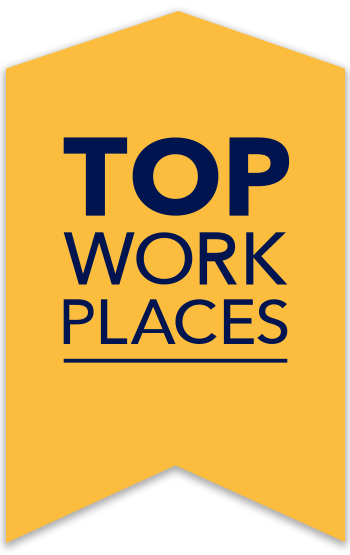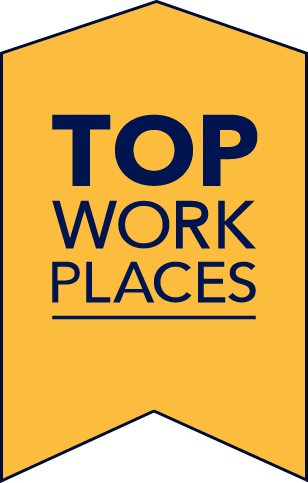Increasing pressure to make more money, retain top talent, and stay innovative can pull company leaders in many different directions. A leader’s job is never-ending and overwhelming, but successful leadership teams know the most important task on their day-to-day agenda is improving performance.
One of the most essential qualities of a good manager or leader is making sure employees have all the tools necessary for success. It is much easier to reach and exceed performance goals as a company when leadership connects, motivates, and satisfies their teams. Without high levels of production and performance, leaders’ responsibilities multiply and become even more time-consuming.
The effect of leadership on employee performance is substantial. Performance levels are higher at Top Workplaces because leaders at those companies are tuned into employees’ needs and preferred work styles. Strengthening the relationship and communication channels between employees and leaders multiplies company performance and proves how much leaders impact organizational culture and productivity.
Learn more: Qualities of a Good Manager
What are the different types of leadership styles?
Although most leaders develop a unique leadership style, there are three main types of leadership to note:
- Autocratic leaders prioritize efficiency, results, and independent decision-making. These leaders usually make business decisions on their own or with limited other people. They also make a clear distinction between themselves and their employees to maintain authoritarian-like control. Autocratic leadership is useful when companies have higher levels of compliance, safety precautions, and supervision requirements.
- Democratic leaders make decisions only after considering input from all relevant stakeholders. It’s common for democratic leaders to consult others often throughout group discussions. This leadership style usually makes employees feel more engaged in company decision-making processes.
- Participative leaders rely on trusted team members to make decisions for them. This leadership style encourages people of all seniority levels to share their ideas and input. Participative leaders only offer decision-making or guidance when requested. They also save time by delegating.
How to evaluate employee performance based on leadership style
Because of the impact of leadership style on employee performance, companies can use leadership styles to benchmark against other similar organizations. For example, autocratic leadership styles generally improve short-term performance and productivity, while participative leadership styles show more effectiveness in long-term performance.
A combination of the two, the democratic leadership style improves both long and short-term performance. The best results come from combining multiple leadership styles based on your current performance needs and goals. That means flexible and versatile leadership is a plus.
How leadership affects employee performance
Employee performance depends on many variables, but leadership has one of the most substantial impacts. High-performance leaders achieve success by constantly evolving and learning from their employees.
Are you curious about how leadership affects employee performance at your company? Leaders’ impact is usually widespread, so there are plenty of areas to explore.
Employee motivation
Motivating employees and managers is one of the most impactful ways leaders can improve their company’s performance and productivity. Just think about the last time a leader inspired you to work harder or reconnect with the company’s mission. Chances are, it worked because those words of motivation increased your sense of meaning and personal value within the company.
Employee engagement
Especially in today’s world of scrolling and attention issues, it’s crucial for leaders to engage employees in fresh, meaningful, new ways — for people and profits’ sake.
Engagement is a key component of productivity, company culture, and well-being. Engaged employees tend to perform better and feel more connected to the company, which means higher productivity and positivity.
Surveying your employees is the best way to gauge engagement, but if you’re in a pinch, here are some signs of engaged employees.
Employee trust
Employee trust is another way that leadership can directly impact performance and productivity. If employees don’t trust their leaders or the direction of the company, then their performance and productivity numbers will drop. Improving trust starts with creating a positive environment, following up, listening actively, and telling the truth.
Employee growth
Employee growth opportunities are another way leadership can improve performance — and its quality. Growth opportunities naturally improve employee performance by showing individuals that the organization wants them to reach their highest potential. The benefits of employee training and development are countless but include improved retention, increased ability to promote from within, and more efficient workflows.
Employee creativity
Does your company struggle with creativity? Research shows that leadership has a massive impact on employee innovation. Leaders are naturally creative and future-oriented, but they sometimes need to remember to encourage others to be creative. When leaders cultivate a creative, open-minded culture, they see improvements in competitive innovation, productivity, and shared ideas. Plus, creativity improves employee satisfaction and well-being.
Employee passion
If you’ve ever had a passionate leader, you know it’s contagious. Passionate leaders increase company purpose by connecting employees to a shared mission, values, and vision. Passionate employees tend to stay positive during difficult situations and remind others about the bigger picture.
Leaders are more likely to reach and exceed performance goals when everyone is feeling passionate and positive — including themselves. That energy will attract and retain more customers too.
Company culture
Great leaders understand the impact of leadership style on employee performance and how much it has to do with the culture they create. Great leaders improve company culture because they know it will help their employees, but also because they know it will have a direct impact on efficiency, performance, and productivity. Building and maintaining a culture that supports your performance goals should be top of mind, especially if company growth is in your future.
Employee efficiency
Leaders don’t tell their employees to be more efficient. They create efficient systems themselves by asking for feedback and providing solutions. Individuals look up to leadership for help, so it’s crucial to guide them in the most efficient way possible. That way, more employees understand and communicate the importance of efficiency, which boosts productive performance.
Employee confidence
And finally, when looking at the impact of leadership style on employee performance, you must consider employee confidence. A secret weapon for productivity, confidence is interwoven into many other previously-discussed initiatives because it works so well.
Overall company performance improves when leaders use employee recognition to acknowledge, celebrate, and show appreciation for their workforce. It may seem minor but boosting employee confidence is a great way to improve everything from company culture to customer service. Leaders must be role models in this process to ensure that all managers and employees continue to motivate each other toward higher performance levels.
Monitor and celebrate performance with Top Workplaces
Employee feedback is the perfect tool to identify how leadership impacts your organizational performance. Top Workplaces’ Workplace Survey has many other benefits, including improved brand recognition, company communication, efficiency, and recruitment.
Plus, the Top Workplaces team is here to help interpret survey results, so your organization can continue to focus on performance, productivity, and profitability goals.
Already have a great leadership team? Get the recognition you deserve with a Top Workplaces for Leadership award. Nominate your organization today to keep up the progress and celebration.

 Stand out with an award-winning
Stand out with an award-winning
